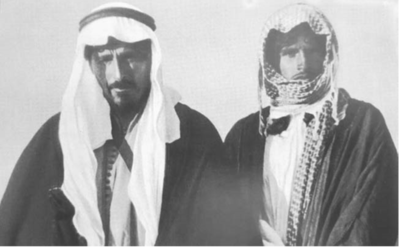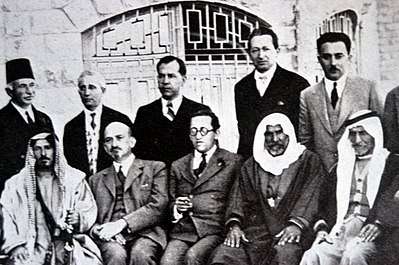Mithqal Al Fayez
Mithqal Sattam Fandi Al Fayez (Arabic: مثقال الفايز , (circa 1885 – 1967) is a historical Jordanian political and tribal figure whose work helped the establishment of a Hashemite Jordan. Mithqal was one of the two leading sheikhs of Bani Sakhr, he took power in the early twentieth century, and headed the Al-Twaga half of the Bani Sakhr tribe, which consisted of the Al-Ghbein, Al-Amir, Al-Ka'abna, Al-Hgeish, Al-Saleet, and Al-Taybeen clans. He also headed his own clan, Al-Fayez.
Mithqal Sattam Al-Fayez | |
|---|---|
.png) Sheikh Mithqal's image from the cover of Yoav Alon's Shaykh of Shaykh award winning book. | |
| Born | Um Al-Amad, Madaba, Jordan. |
| Died | April 14, 1967 (aged 86) |
| Resting place | Um Al-Amad, Madaba, Jordan. |
| Occupation | Political and tribal leader |
| Years active | 1921–1967 |
| Title | Pasha (Given by Mehmed V) Sheikh of Sheikhs (Given by Abdullah I of Jordan Sheikh of Bani Sakher |
| Relatives | Faisal Al-Fayez(Grandchild)
Hakem Al-Fayez(Grandchild) Hind Al-Fayez(Great-grandchild) |


Early life
Mithqal Sattam Al-Fayez was born into the family of the leading shaykhs of the Bani Sakhr tribal confederacy around the year 1880. For two generations, his immediate family had led the confederacy, one of the largest and strongest nomadic tribal groups in the Syrian Desert. As such, his childhood was spent in preparation for the title and job of a shaykh, the tribal leader. An Arab shaykh had to demonstrate the virtues of wisdom, charisma, generosity, and courage, find victory in battle, and develop an intimate knowledge of the desert. He would hone his negotiating skills to represent the tribe vis-à-vis other tribes and government officials and would need to secure economic resources for himself and his people. At the conclusion of this long training and learning process, this boy would still be expected to compete with his brothers, cousins, and nephews for the leadership of the Bani Sakhr people.
Mithqal’s childhood years occurred during a time of a great change in the desert. A decade prior to his birth, the Ottoman Empire had begun incorporating the southern regions of its Syrian province, east of the Jordan River, into its central rule. The tribes, long accustomed to their local rule and autonomy, suddenly had to adjust to sharing power with the Ottoman government. The success of Mithqal’s grandfather(Fandi) and father(Sattam) in adapting to this new political reality was crucial. Their legacy paved the way for Mithqal’s own greatness at a time of great geopolitical transformations. It also shaped the future leader’s worldview, one that would guide him throughout his entire life.
Rise to power
Mithqal was gifted with exceptional military skills, which he had acquired while still with the Ruwala. Now, back with the Bani Sakhr, he had plenty of opportunities to demonstrate them. Mithqal quickly made a name for himself as a leader of raids. Though there are no concrete details on the actual battles in which he took part, a few pieces of information illustrate his military role among the Bani Sakhr and the reputation he earned as a result. Ultimately, his success and courage earned him valuable credentials, as expected from a member of a respectable shaykhly family, providing him with the springboard to the position of leadership.
Mithqal had another advantage while he was making his way. The fact that his elder brother, Fawwaz, was the leader of the Bani Sakhr greatly strengthened his political position. Even if there was some tension between the brothers at first, they soon reconciled, and Mithqal became Fawwaz’s right-hand man. A newspaper report from 1913 implies that the two shaykhs were acting as partners in the leadership of the Bani Sakhr under Ottoman patronage. By that time, they were generally known for their friendship with the government and faced internal opposition for that reason. When a famous warrior of the Bani Sakhr and an outlaw wanted to defy the government, he set fire to Mithqal’s and Fawwaz’s threshing floors and stole their cattle.16 Fawwaz’s reliance on Mithqal may have been the result of affection for his young brother, regard for his military skills, or fear of his power and potential competition. Whatever the case, Mithqal was an asset to Fawwaz as a military leader, particularly in light of the unstable relations between the tribes and the Ottoman government and the impending threat of the Young Turks to curtail their autonomy.
Upon Fawwaz’s death in the summer of 1917, Mithqal saw himself as the new leader and made his first bid to become the shaykh of shaykhs of the Bani Sakhr. A British intelligence report indicated that Mithqal “was mentioned as his successor.”23 However, Mithqal lost to his seventeen-year-old nephew, Mashhur, the son of the deceased leader. The tribal council preferred the young Mashhur, who was a graduate of a school in Damascus, to the illiterate Mithqal, even though the latter was more mature and experienced.
One of the first decisions concerning tribal affairs that Abdullah was to take had considerable implications for Mithqal’s career. Abdullah recognized Mithqal as the new shaykh of shaykhs of the Bani Sakhr. This promotion came immediately after the death of the incumbent Mashhur in intertribal fighting and was apparently a natural and uncontested choice. Finally, Mithqal’s title matched his actual status. With this appointment, Mithqal attained the goal he had been striving to achieve for years.
Ambush of the 1930s
Mithqal was riding his mare in the desert accompanied by only one man. It was during the winter season, and the Bani Sakhr had migrated east towards Wadi Sirhan. Suddenly, Mithqal and his escort were surprised by an ambush set by members of an enemy tribe. A bullet grazed the side of Mithqal’s head, almost killing him, and he was hit in the shoulder. Mithqal and his escort fired back and managed to drive off their attackers, but Mithqal was badly wounded. His escort tied a piece of cloth around his bleeding shoulder, pulled him over his mare, and rode on quickly to seek aid. They arrived in the nearby camp of a Bani Sakhr tribesman and asked for his help in fetching a car to take Mithqal to a hospital. He sent one of his men by camel to the encampment of Shaykh Haditha al-Khuraysha, who in turn sent a messenger to Amman. A car finally arrived, but in the meantime, Mithqal was suffering from loss of blood and in great pain. Mithqal spent twenty days in an Amman hospital. He survived, but the damage was irreversible. For the rest of his life, he could hardly use that arm, which dangled nearly lifeless from his shoulder.
Last years
Mithqal's health soon began deteriorating soon after the death in 1962 of his favorite wife ‘Adul, ‘Akif’s mother, which was a severe blow to Mithqal. In the last five years of his life, he suffered from progressively declining health. Though he was fortunate enough to receive superb medical treatment in Cairo, Beirut, and Europe, diabetes and other age-related illnesses brought about his death in his late eighties in April 1967.
Jordan after Mithqal

Even in death Mithqal played a fateful role in Jordanian politics. In 1967, an election was held following the dissolution of Parliament, which, under ‘Akif’s leadership, was hostile to the government of Wasfi al-Tall, Jordan’s most celebrated prime minister. Wasfi was determined to bring about the downfall of his bitter enemy ‘Akif by supporting another candidate for the Bani Sakhr seat. But in order to prevent this further blow to the bereaved family, King Hussein intervened personally and secured ‘Akif’s election. Thus, in dying, as it turned out, Mithqal had secured a prominent position for his son for many years to come. Two months later, Jordan lost the West Bank to Israel in the Six Day War, and since its Parliament was elected by voters on both banks of the Jordan River, no general elections could take place until the country’s political disengagement from the West Bank. This did not occur until 1988, and in the interim, ‘Akif was able to keep his seat, holding it for the next twenty-one years and even serving as speaker of Parliament again between 1984 and 1988.
The mourning period was over and the dignitaries and ordinary people left Mithqal’s house. The bereaved family was left to deal with the huge void created by Mithqal’s demise. It was undisputed that the elder son, ‘Akif, would become the head of the family and the main bearer of his father’s legacy. But he was not recognized as shaykh of shaykhs. Perhaps Mithqal was too large a personality to be replaced by anyone else. Besides, times were changing, and King Hussein’s drive to modernize the country suggested that such institutions were anachronistic. Whatever his reasons, the king had a perfect excuse, and for many years that seat had remained vacant.
One of the first things the family did was to gather to distribute Mithqal’s huge landholdings. By the time of his death, Mithqal had accumulated at the very least 120,000 dunams (30,000 acres). By his instructions, two grandchildren, the sons of his eldest son Sultan, whom he raised as his own after their father’s premature death, enjoyed equal shares of the inheritance.1 Several years later, the family sold a large portion of that land to the Jordanian government. Today, Amman International Airport stands on what used to be Mithqal’s fields and the pastures in which his camels and sheep grazed.
References
- Aṣ-Ṣalībī Kamāl Sulaymān. The Modern History of Jordan. I.B. Tauris, 2010.
- Alon, Yoav. The Shaykh of Shaykhs: Mithqal Al-Fayiz and Tribal Leadership in Modern Jordan. Stanford University Press, 2016.
- Lieber, Dov. “How Jordan's 'Sheikh of Sheikhs' Negotiated with Zionists, Founded a Kingdom.” The Times of Israel, 3 Sept. 2016, www.timesofisrael.com/how-jordans-sheikh-of-sheikhs-negotiated-with-zionists-founded-a-kingdom/.
- Peake, Pasha. A History of Jordan and Its Tribes. University of Miami Press, 1958.